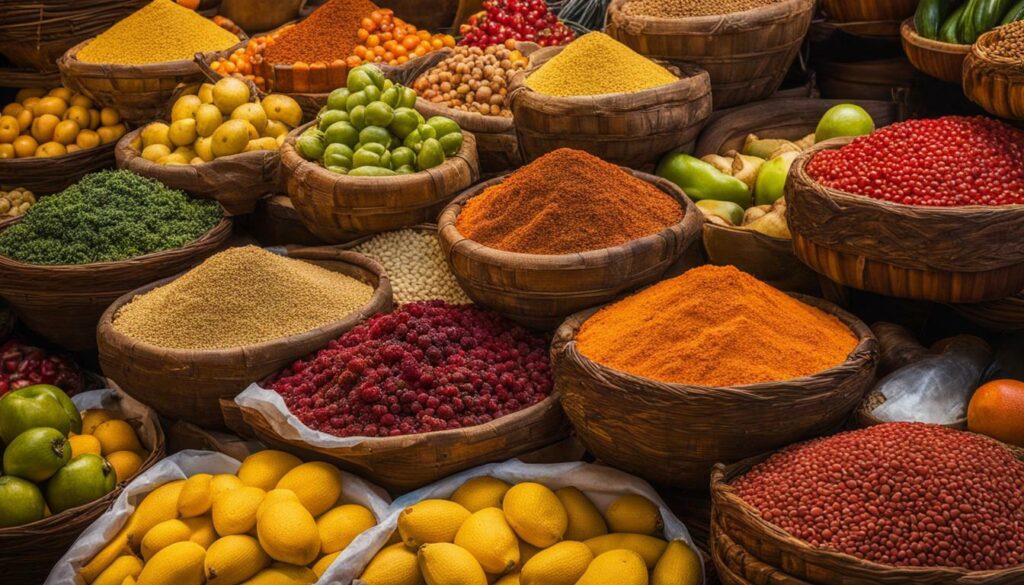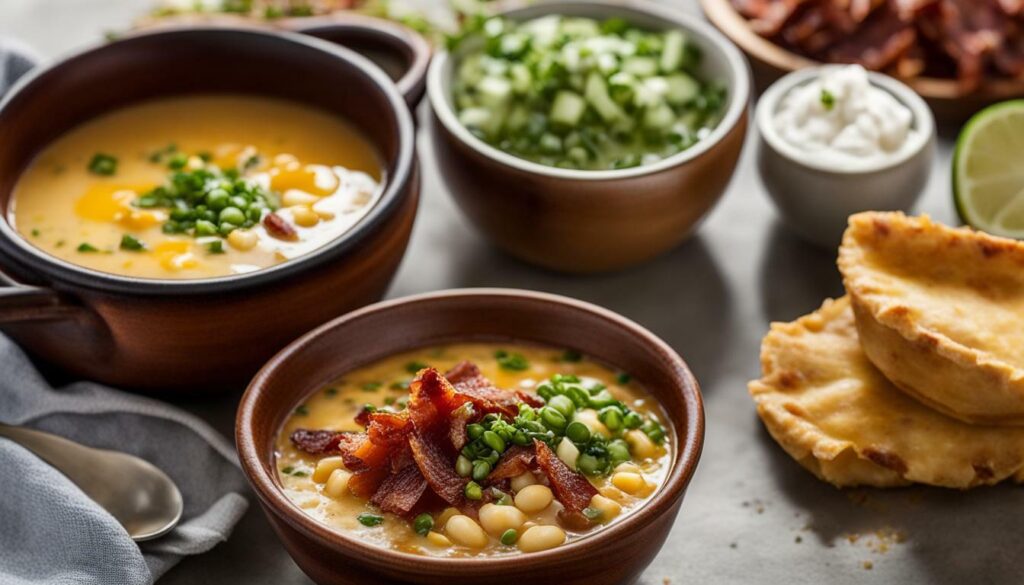Argentina’s culinary traditions have a rich history, with a blend of indigenous, Spanish, and Italian influences shaping its past and present diets. From traditional Argentinian foods to the impact of Italian immigrants on the country’s cuisine, Argentina offers a unique gastronomic experience that reflects its cultural heritage.
Key Takeaways:
- Argentina’s culinary traditions are a fusion of indigenous, Spanish, and Italian influences.
- Traditional Argentinian foods include pizzas, milanesas, and beef dishes.
- Italian immigrants have significantly influenced the country’s cuisine.
- The traditional asado is a prominent feature of Argentine gastronomy.
- Argentine cuisine is known for its unique flavours and diverse culinary customs.
Traditional Foods of Arentina
Argentinian cuisine is known for its array of traditional foods which are deeply rooted in the country’s history and national identity. From succulent steaks to mouthwatering empanadas, these dishes showcase the rich cultural heritage of Argentina. Let’s explore some of the most beloved traditional foods that have become iconic to the country’s gastronomy.
1. Asado: The traditional Argentine barbecue, known as the asado, is a feast that brings families and friends together. It involves grilling various cuts of succulent beef over an open fire, resulting in tender and flavorful meat. The asado is a social event that celebrates both food and friendship, and it is a must-try for anyone visiting Argentina.
2. Empanadas: These delicious pastries are a staple in Argentine cuisine. Empanadas are stuffed with a variety of fillings, including beef, chicken, cheese, or vegetables, and then baked or fried to perfection. They are often enjoyed as a street food snack or as an appetizer during family gatherings.
3. Milanesas: Inspired by Italian cuisine, milanesas are breaded and fried meat cutlets that can be made with beef, chicken, or veal. They are typically served with a squeeze of lemon juice and often accompanied by mashed potatoes or a fresh salad. The crispy exterior and tender meat make milanesas a delightful comfort food.

“Argentinian cuisine is a delightful blend of flavors, influenced by historical and cultural factors. The traditional foods of Argentina not only satisfy the taste buds but also tell a story of the country’s culinary heritage. From indulgent barbecues to savory pastries, these dishes are a true reflection of Argentina’s vibrant food culture.” – Food critic
These traditional foods of Argentina are just a glimpse into the culinary delights that await visitors to this South American country. The blend of indigenous, Spanish, and Italian influences has created a unique and diverse gastronomic experience. So, make sure to sample these iconic dishes and immerse yourself in the flavours that define Argentina’s rich culinary traditions.
Italian Influence on Argentine Cuisine
The arrival of Italian immigrants in the 19th century greatly influenced the culinary scene in Argentina, leaving a lasting impact on the country’s traditional foods. These immigrants brought with them their rich gastronomic heritage, including iconic dishes such as pizza, pasta, and risotto. Argentinians quickly embraced these new flavours, blending them with their local ingredients to create a unique fusion of Italian and Argentine cuisine.
One of the most prominent Italian-influenced dishes in Argentina is the milanesa, a breaded and deep-fried meat cutlet. Similar to the Italian dish, veal Milanese, the Argentinian milanesa is typically made with beef and is served with a variety of accompaniments, such as mashed potatoes or a fresh salad. It has become a beloved staple on many Argentinian dining tables.
This Italian influence is also evident in another popular Argentinian dish, “porteñisima” or “superpanchos”. This dish is a variation of the traditional Italian sausage sandwich, known as “panino di salsiccia”. In Argentina, the sausage, or “chorizo”, is typically flame-grilled and served on a bun with various toppings, such as chimichurri sauce, sauerkraut, and mustard. It has become a go-to street food option enjoyed by locals and tourists alike.
The Italian influence on Argentine cuisine has not only enriched the flavors and variety of traditional foods but has also become an integral part of the country’s culinary identity. Today, visitors to Argentina can indulge in a wide array of Italian-inspired dishes while still experiencing the unique tastes and traditions of Argentinian gastronomy.

Argentina’s Love for Beef
When it comes to Argentine cuisine, it is impossible to overlook the country’s deep-rooted love for beef, which forms an integral part of traditional meals and national dishes. Argentineans take great pride in their beef, and it is not uncommon to find succulent steaks grilling on every street corner. The cuisine is heavily influenced by the gaucho tradition, where cattle ranching has been a way of life for centuries.

Argentina is renowned for its asados (barbecues), where beef takes centre stage. Thick, juicy cuts of beef are grilled to perfection over an open fire, creating a smoky and mouth-watering flavour. This culinary tradition brings people together, as families and friends gather around the grill to enjoy the aromatic meats, accompanied by chimichurri sauce and an array of side dishes.
In addition to the asado, beef is also a key ingredient in many traditional Argentinian dishes. From empanadas, which are savoury pastries filled with seasoned ground beef, to locro stew, a hearty combination of beef, corn, and beans. Argentinians have mastered the art of incorporating beef into their cuisine, resulting in rich and robust flavours that will satisfy any meat lover’s appetite.
To truly understand the significance of beef in Argentina, one must experience the taste of their national dish, the famous bife de chorizo. This thick sirloin steak is cooked to perfection, with a charred exterior and a tender, juicy interior. It is often served with chimichurri sauce, salad, and crispy fries, creating a dish that represents the essence of Argentinian cuisine.
| Traditional Argentinian Dishes | Description |
|---|---|
| Empanadas | Savory pastries filled with seasoned ground beef, onions, and traditional spices. |
| Locro | A hearty stew made with beef, corn, beans, and pumpkin, often enjoyed during special occasions. |
| Choripan | A popular street food consisting of grilled chorizo sausage served in a crusty bread roll. |
| Asado | A traditional barbecuing technique where various cuts of beef, sausages, and offal are grilled over an open fire. |
Traditional Argentine Meals
Traditional Argentine meals are often characterized by simplicity in terms of seasoning but are still packed with flavour, showcasing the country’s emphasis on quality ingredients. The cuisine is a delightful blend of cultural influences, resulting in a unique gastronomic experience. From hearty stews to indulgent barbecues, Argentina’s traditional meals are a testament to its rich culinary heritage.
One iconic dish is the empanada, a savoury pastry filled with various ingredients such as beef, chicken, cheese, or vegetables. These handheld delights are perfect for on-the-go snacking or as appetizers during social gatherings. Another beloved Argentine staple is the choripan, a popular street food consisting of grilled chorizo sausage served on a crusty bread roll. This simple yet delicious combination is a favourite among locals and visitors alike.
For those seeking a taste of traditional Argentine comfort food, the locro stew is a must-try. Made with white corn, beans, meat, and a medley of vegetables, this hearty dish is often enjoyed during national holidays and family gatherings. Each spoonful of this flavorful stew reflects the country’s rich culinary history.

While Argentina is renowned for its beef, it offers so much more than just steaks. The country is also known for its delicious pastas, influenced by the Italian immigrants who sought a new life in Argentina. Pasta dishes like ravioles and tallarines are commonly enjoyed as part of an Argentine meal, adding a touch of Mediterranean influence to the culinary tapestry.
Whether it’s indulging in empanadas, savouring a sizzling asado, or relishing a comforting bowl of locro stew, exploring traditional Argentine meals is a feast for the senses. Each bite tells a story of cultural heritage and culinary passion, making Argentina a destination that truly delights food enthusiasts.
Argentine Breakfasts and Light Fare
Argentine breakfasts are typically light, with a common choice being coffee accompanied by medialunas, sweet crescent-shaped pastries. These delicious pastries are a staple of Argentine morning rituals. Made from buttery dough and often sprinkled with sugar, medialunas are the perfect accompaniment to a strong cup of coffee, providing a sweet and indulgent start to the day.
Aside from medialunas, other popular options for a light breakfast in Argentina include tostadas, which are crispy slices of bread often served with butter and jam, or a simple bowl of cereal with milk. Argentines also enjoy their breakfasts with a glass of freshly squeezed orange juice, providing a refreshing burst of citrus flavour to start the day.
For those who prefer a heartier meal in the morning, there are also savoury options available. Toasted ham and cheese sandwiches or a traditional Argentinian tortilla, a thick omelette filled with vegetables or meat, are both satisfying choices. These savoury breakfasts provide a more substantial start to the day, ensuring that one is fueled and ready for whatever lies ahead.

Traditional Argentine Breakfast Options:
| Food | Description |
|---|---|
| Medialunas | Sweet, crescent-shaped pastries made from buttery dough. |
| Tostadas | Crispy slices of bread served with butter and jam. |
| Cereal | A bowl of cereal with milk. |
| Ham and Cheese Sandwich | Toasted sandwich with ham and cheese. |
| Tortilla | A thick omelette filled with vegetables or meat. |
Whether one prefers a sweet or savoury start to the day, Argentine breakfasts offer a range of options to suit every taste. From the delicate sweetness of medialunas to the comforting flavours of toasted sandwiches, these breakfast choices reflect the diverse culinary traditions of Argentina.
The Traditional Asado (Barbecue)
The traditional asado, a revered culinary ritual in Argentina, brings people together for a feast centred around grilled meats, creating an atmosphere of celebration and camaraderie. Argentinian traditional foods are deeply rooted in the cultural fabric of the nation, and the asado is no exception. It is a festive occasion that showcases the country’s love for meat and the art of grilling.
The star of the show at an asado is undoubtedly the beef. Argentina is renowned for its high-quality beef, and it takes centre stage at this gathering. Succulent cuts of meat, such as ribeye, sirloin, and short ribs, are expertly seasoned with salt and cooked over an open fire or parilla. The slow process of grilling allows the flavours to develop and results in tender and juicy meat that is second to none.
In addition to beef, the asado often includes other types of meat, such as sausages, chorizo, and morcilla (blood sausage). These meats are typically cooked alongside the beef, infusing the air with an irresistible aroma. As the meat sizzles and caramelizes on the grill, anticipation builds among the guests, who eagerly wait for the delicious feast that lies ahead.
Accompanying the grilled meats are various side dishes and condiments. Chimichurri, a sauce made with parsley, garlic, vinegar, and oil, is a staple at every asado. Its vibrant green colour and fresh flavours complement the rich and smoky meat perfectly. Other popular accompaniments include simple salads, grilled vegetables, and crusty bread.

The asado is not just a meal, but a social event that brings families and friends together. It is a time for laughter, storytelling, and bonding over shared traditions. The long hours spent tending to the fire and watching the meat slowly cook create a relaxed and convivial atmosphere, where everyone can unwind and enjoy each other’s company.
The tradition of the asado is deeply ingrained in Argentinian culture, and it is a testament to the country’s rich culinary heritage. It represents more than just a method of cooking meat; it embodies a way of life, a celebration of food, and an expression of hospitality. So, the next time you find yourself in Argentina, make sure to partake in this festive culinary experience and savour the flavours of a traditional asado.
Popular Argentine Dishes
Argentina boasts a variety of popular dishes that have become synonymous with the country’s culinary landscape, captivating both locals and visitors alike. From succulent steaks to savoury empanadas, these iconic foods showcase the rich flavours and cultural heritage of Argentina.
One renowned dish is the traditional Argentine empanada, a pastry filled with various ingredients such as beef, chicken, cheese, or vegetables. These handheld delights are often enjoyed as a snack or appetizer and can be found in numerous regional variations across the country. Whether baked or fried, empanadas offer a tantalizing combination of flavours and textures, making them a must-try for any food lover visiting Argentina.

Another beloved dish is the choripan, a popular street food that showcases Argentina’s love for grilled meats. This simple yet delicious sandwich consists of a grilled chorizo sausage served on a crusty bread roll, often accompanied by chimichurri sauce for an extra burst of flavour. Whether enjoyed at a local food stall or during a backyard barbecue, the choripan is a staple in Argentine cuisine that offers a satisfying combination of smoky, juicy meat and crunchy bread.
For those seeking a hearty and comforting meal, locro stew is a classic Argentine dish that is sure to delight. This thick and flavorful stew is made with a variety of ingredients, including corn, beans, meat, and spices. Locro is traditionally enjoyed during the winter months and is often prepared in large quantities to be shared among family and friends, highlighting the communal nature of Argentine dining.
| Dish | Description | Image |
|---|---|---|
| Empanadas | Pastries filled with various ingredients such as beef, chicken, cheese, or vegetables |  |
| Choripan | Grilled chorizo sausage served on a crusty bread roll, often accompanied by chimichurri sauce |  |
| Locro | Thick and flavorful stew made with corn, beans, meat, and spices |  |
These are just a few examples of the famous foods that have become an integral part of Argentine cuisine. These dishes reflect the country’s diverse culinary influences and the passion Argentinians have for good food and communal dining. Whether you’re exploring the bustling streets of Buenos Aires or touring the picturesque landscapes of the country, be sure to indulge in these iconic dishes for a true taste of Argentina.
Culinary Diversity and Influences
The culinary scene in Argentina is a testament to its rich history and cultural diversity, blending elements from different traditions to create a unique and flavorful cuisine. With influences from Spanish, Italian, and indigenous flavours, Argentinian cuisine offers a wide variety of dishes that cater to every palate.
Italian immigrants played a significant role in shaping the gastronomy of Argentina, bringing with them their traditional recipes and techniques. Italian-influenced dishes such as pizzas and deep-fried milanesas have become a staple in Argentina’s culinary repertoire. The thick-crust pizzas topped with an abundance of cheese and various toppings are a popular choice among locals and tourists alike. Additionally, massive steaks and loaded fries drenched in cheese and bacon showcase the country’s love for meat and indulgence.
Traditional Argentine meals are known for their simplicity yet bold flavours. While they may lack excessive seasoning, the quality of the ingredients shines through in every bite. Empanadas, with their savoury fillings enclosed in a flaky pastry, are a classic example of the country’s culinary ingenuity. Choripan sandwiches, made with grilled chorizo and topped with chimichurri sauce, are another favourite street food item that exemplifies the fusion of flavours found in Argentinian cuisine.

Furthermore, Argentina’s love for beef is widely recognized, and the traditional asado is a prime example of this passion. Asados are grand barbecues where families and friends come together to enjoy an array of grilled meats, including succulent steaks, sausages, and ribs. The asado is not just a meal; it is a festive celebration that embodies the spirit of communal feasting and the country’s deep-rooted appreciation for meat.
The fusion of Spanish, Italian, and indigenous influences has contributed to the diverse and vibrant culinary landscape of Argentina. From the hearty locro stew, made with corn, meat, and various vegetables, to the delicate flavours of Argentine desserts such as dulce de leche-filled alfajores, this country offers a range of dishes that cater to all tastes. Whether you are exploring the bustling streets of Buenos Aires or venturing into the countryside, you are sure to encounter a gastronomic experience that is both unique and memorable.
Conclusion
The past and present diets of Argentina reflect a captivating culinary journey, showcasing a blend of historical influences and contemporary adaptations that make it a truly remarkable gastronomic destination. With a rich history of food in Argentina, the traditional foods of the country have become iconic and celebrated worldwide.
One of the most significant influences on Argentine cuisine is the Italian immigrants who arrived in the country in the 19th century. Their contribution has shaped the culinary landscape, resulting in a fusion of Italian and Argentine flavours. From the thick-crust pizzas with overflowing cheese toppings to the deep-fried milanesas, the Italian influence in Argentina is undeniable.
When it comes to traditional Argentine meals, they may lack elaborate seasoning but are still bursting with flavour. The cuisine is known for its generous portions of beef, with massive steaks and loaded fries dripping with cheese and bacon being popular indulgences. Argentine breakfasts, on the other hand, tend to be lighter, with most people enjoying a cup of coffee and medialunas, a type of croissant.
No exploration of Argentine cuisine would be complete without mentioning the traditional asado, a grand barbecue that showcases the country’s passion for meat. This communal feast, often enjoyed on special occasions, brings people together over an array of grilled meats and delicious sides.
Other popular dishes in Argentina include empanadas, choripan sandwiches, and locro stew. These dishes exemplify the fusion of Spanish, Italian, and indigenous influences that have shaped Argentine cuisine. The result is a unique and diverse culinary experience that is sure to delight food lovers.
Whether you’re exploring the history of food in Argentina, indulging in traditional Argentinian dishes or experiencing the fusion of flavours, the past and present diets of Argentina offer a tantalizing journey that celebrates the country’s gastronomic heritage. From the traditional foods steeped in history to the contemporary adaptations that reflect modern tastes, Argentina continues to captivate and entice with its vibrant and diverse cuisine.
FAQ
What are some traditional foods of Argentina?
Traditional foods in Argentina include pizzas, deep-fried milanesas, massive steaks, loaded fries, empanadas, choripan sandwiches, and locro stew.
How has Italian cuisine influenced Argentine cuisine?
Italian immigrants who arrived in Argentina in the 19th century have had a significant influence on Argentine cuisine, particularly in the introduction of dishes like pizzas and milanesas.
What is the significance of beef in Argentine cuisine?
Beef is a staple ingredient in many traditional Argentine dishes and is a central focus of the country’s famous asado (barbecue) tradition.
What are traditional Argentine meals like?
Traditional Argentine meals are often characterized by a lack of seasoning but are still flavorful. They typically feature large portions of beef, accompanied by other dishes like empanadas, choripan sandwiches, and locro stew.
What do Argentinians typically have for breakfast?
Argentine breakfasts are usually light, with many people opting for coffee and medialunas (sweet croissants).
What is the traditional asado in Argentina?
The traditional asado is a grand barbecue feast that showcases Argentina’s passion for meat. It is a major part of Argentine culture and can be enjoyed on various occasions with friends and family.
What are some popular Argentine dishes?
Some popular dishes in Argentina include pizzas with overflowing cheese toppings, empanadas filled with various ingredients, choripan sandwiches made with grilled sausage, and locro stew made with corn, meat, and vegetables.
What influences have shaped Argentine cuisine?
Argentine cuisine is a blend of Spanish, Italian, and indigenous influences, creating a unique and diverse culinary experience.
Source Links
- https://www.saboresatlanta.com/argentinian-food/
- http://wesleyanargus.com/2023/02/06/worldwide-wes-exploring-argentinian-cuisine/
- https://www.frontiersin.org/articles/10.3389/fnut.2022.778390



